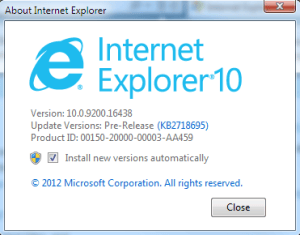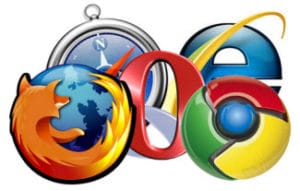Old Web Browser
 Old Web Browser: a reader asks…
Old Web Browser: a reader asks…
I guess I’m a Luddite, I still use Internet Explorer on my Windows 7 computer. I keep seeing Microsoft trying to get me to upgrade to version 11, but I’m not sure why I should bother. I’m using version 10. Do I really need to upgrade?
In a word, yes. Internet Explorer 10 is a security vulnerability waiting to happen. Microsoft ended supporting that (also older versions of IE, and also Windows 8) back in January 2016. So your web browser isn’t getting any security updates, and the hackers are working overtime discovering and exploiting holes in IE10. Visit Windows Update on your computer and get Internet Expolorer 11, I promise you won’t be sorry. IE11 is faster and uses less resources than IE10, plus it’s more stable (less likely to freeze or crash), and is more compatible with websites. And did I say safer? Yes!
 For anyone using an older version of a web browser, whether it’s Internet Explorer, Google Chrome, Mozilla Firefox, Opera, or even Safari on Mac or PC, you really need to update to the latest version. For Chrome, Firefox and Opera, just click the browser’s settings menu and click About … (Chrome, Firefox, or Opera). The web browser will start downloading the latest version immediately. For Internet Explorer, you need to use Windows Update – if that’s not working for you, you can download it from Microsoft. Mac users can just open the App Store and visit the Updates tab (older Macs may have to kick off System Updates from the main Mac menu). If you use Safari on a Windows PC, well, perhaps you shouldn’t – Apple hasn’t updated that in a good long while.
For anyone using an older version of a web browser, whether it’s Internet Explorer, Google Chrome, Mozilla Firefox, Opera, or even Safari on Mac or PC, you really need to update to the latest version. For Chrome, Firefox and Opera, just click the browser’s settings menu and click About … (Chrome, Firefox, or Opera). The web browser will start downloading the latest version immediately. For Internet Explorer, you need to use Windows Update – if that’s not working for you, you can download it from Microsoft. Mac users can just open the App Store and visit the Updates tab (older Macs may have to kick off System Updates from the main Mac menu). If you use Safari on a Windows PC, well, perhaps you shouldn’t – Apple hasn’t updated that in a good long while.
Web browsers are so directly tied to the internet that security vulnerabilities are pretty much a given. That’s why the makers of those web browsers issue updated versions as often as they do. For every new feature released, there are usually a dozen or so vulnerabilities that have been discovered and patched. So don’t delay, get the latest version for the web browser you use.
One caveat on the above advice. If you’ve upgraded to Windows 10, you’ll notice Microsoft is pushing the Windows Edge browser. But it’s still early days for that browser and it is severely handicapped in dealing with all the functionalities you’d expect from a modern web browser. Fortunately, you can get to Internet Explorer 11 by clicking the start button (the not-a-button icon at the bottom-left of your screen), and typing internet explorer. Right-click the IE11 icon and you can add it to the Tiles on the right, or the Taskbar below. You can also set that as your default web browser:
 Click Start, then Settings
Click Start, then Settings- Click the System icon, then click on the Default Apps menu item
- Scroll down to the web browser section and make your choice
It’s ok to use Microsoft Edge, but frankly, I’m not sure I see the point – at least at this point in time. Once Microsoft gets it developed to the point it’ll be able to handle add-ins (aka, extensions or plug-ins), it’s pretty limited in what it can do. Nevertheless, Microsoft automatically sets it up as the default web browser when you upgrade to Windows 10, unless you choose otherwise during setup.
This website runs on a patronage model. If you find my answers of value, please consider supporting me by sending any dollar amount via:
or by mailing a check/cash to PosiTek.net LLC 1934 Old Gallows Road, Suite 350, Tysons Corner VA 22182. I am not a non-profit, but your support helps me to continue delivering advice and consumer technology support to the public. Thanks!
 Click Start, then Settings
Click Start, then Settings






mijn garmin edge explorer is niet compatible met windows 10 wat doe ik daaraan?
I think you are asking about older Garmin devices not being recognized by Windows 10. This issue has been addressed by Garmin and Microsoft.
The solution is to download and install the latest version of Garmin Express software (from https://www.garmin.com/nl-NL/software/express/windows/).
This is from: https://docs.microsoft.com/en-us/troubleshoot/windows-client/backup-and-storage/garmin-usb-devices-not-working